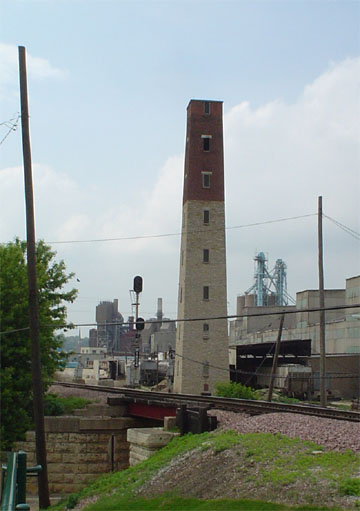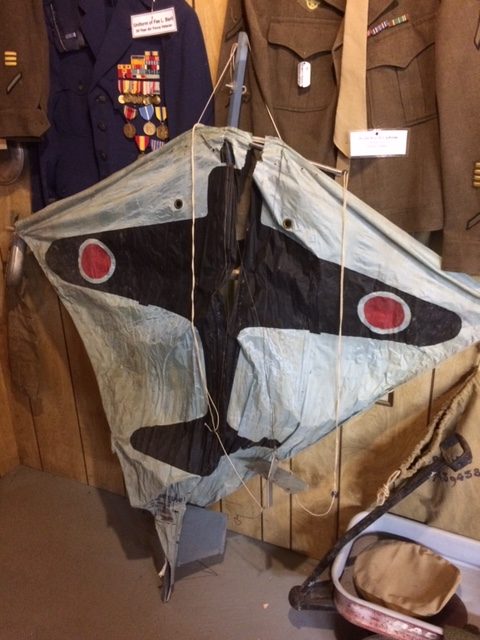Two Odd Bits and a Teaser Hidden in the Footnotes
Every time we take a road trip I end up with a couple of odd bits that I think are fascinating but don’t quite justify an entire blog post. (1) For your amusement and edification I offer two of these today:
The shot tower at Dubuque , Iowa

My Own True Love went out of his way to take me to see the historic shot tower that stands in the industrial section of Dubuque, a reminder of an earlier time when lead mining was a major industry in the region(2) and lead shot was a critical element in military readiness.
As you can see from the attached photos, the shot tower isn’t visually intriguing. In fact, it looks a lot like an abandoned chimney. What made this worth the side trip was the explanation of how a shot tower works, something that both of us were curious about.
For those of you who don’t have a trip to the industrial section of Dubuque in your immediate future, here’s the scoop:
1. You melt lead into liquid.
2. You climb to the top of the shot tower with the molten lead. Or maybe you melt it at the top of the shot tower, which sounds safer. The explanatory panel left this step out.
3. You pour the molten lead through a copper or zinc grate, which ensures that all the shot is approximately the same size instead of breaking up into random shapes like homemade spaetzle.
4. As the lead falls from the top of the tower, surface tension shapes the droplets into spheres.
5. The shot lands in a container of water or sand at the bottom of the tower, which cools the lead and allows the shot to keep its shape.
The process was developed in 1760, after English businessman William Watts discovered that molten lead becomes a perfect sphere when dropped from a great height. (Which raises the question of why he was dropping molten lead from a great height. ) He patented the process, which replaced the slower, more expensive method of casting shot in molds.
2. This item, found in the small local history museum in Guttenberg Iowa(4)
There was no label, but it reminded me of the flash cards used to help plane spotters learn the shapes of enemy airplanes in WWII. According to the senior docent, who wandered in with his grandchildren while we were in the museum, it is a target kite, which was used for gunnery practice at sea in WWII. Who knew?
(1) Or I run out of steam. You might not believe it, but the Road Trip Through History posts require a different kind of energy to write. It’s easiest if I can write them in the moment, but that seldom happens.
(2) And speaking of running out of steam: the lead mines of Dubuque really deserve a blog post of their own. And maybe I’ll suck it up and write one. But not this week. This week we have other historical fish to roll in cornmeal and fry: in my Friday post I’m going to tell you about an exciting collaboration between your humble blogger and the wonderful Exploress podcast. (3) Don’t touch that dial!
(3) One of the best history podcasts out there in my opinion. Here’s the official description:
I love learning about fascinating women in history. But so often, it feels like I’m appreciating them in a cultural vacuum. I mean, what was it really like to be them? To live in their particular time, place, and circumstance?
Welcome to The Exploress, where we’ll go time traveling through women’s history, era by era, to explore their lives and their world, immersing ourselves in their lived experience. We’ll walk with women through their everyday lives, uncovering both the mundane and the bizarre. We’ll discover how they were expected to meet society’s demands to better understand all the ways they subverted them. We’ll go questing for the women behind the famous names we think we know, and meet ladies you’ve probably never heard of.
Give it a try. And if you like it enough to become a Patreon subscriber you’ll have access to a long interview with me about women warriors. That we recorded back in June, plus other subscriber only content.
(4) That’s not a typo. The town spells its name with two “t”s. Back in the nineteenth century, German immigrants voted to change the town’s name from the original Prairie la Porte to Gutenberg in honor of the man who invented moveable type. The town clerk was of French descent and annoyed by the change, so he inserted an extra t into the official documents. Local history is a wonderful things.





